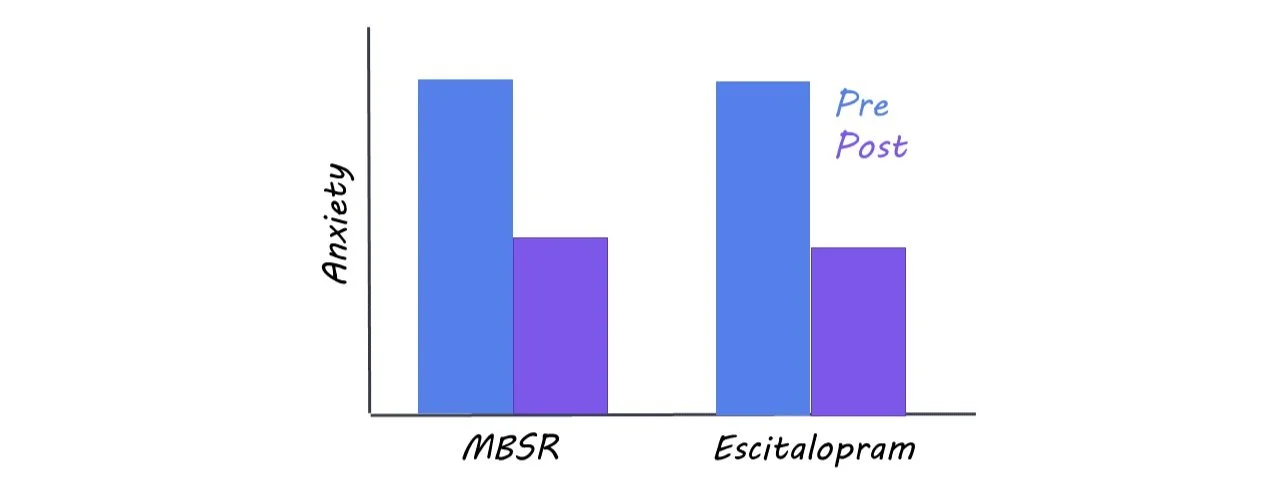How Mindfulness-Based Interventions Compare to Escitalopram as a Treatment for Anxiety
Post by Baldomero B. Ramirez Cantu
The takeaway
Recently, mindfulness-based practices have become popular as potential treatments for psychiatric disorders. This study shows that a mindfulness-based intervention can be just as effective at reducing anxiety symptom severity as escitalopram, an anti-anxiety drug.
What's the science?
Anxiety disorders are remarkably debilitating and affect millions of individuals around the world. These disorders are complex and patients tend to respond differently to similar treatments. For example, some patients experience significant improvement from pharmacological interventions while others experience no improvement in their anxiety and suffer from debilitating side effects while taking the exact same drug and dosage. Today, it remains unclear what effective alternatives exist for those who are not responsive to drug-based treatments or psychotherapy for anxiety disorders. This week in JAMA Psychiatry, Hoge and colleagues assessed how mindfulness-based stress reduction (MBSR) compared to escitalopram in reducing anxiety symptom severity.
How did they do it?
The authors recruited adult patients diagnosed with generalized anxiety disorder, social anxiety disorder, panic disorder, or agoraphobia for a randomized clinical trial. Eligible patients were invited to attend an in-person evaluation with a physician where their baseline anxiety severity was measured using the CGI-S scale. This scale ranks anxiety severity from not anxious at all (CGI-S = 1) to severely anxious (CGI-S = 7) and was used to measure patient anxiety severity throughout the study. Next, the patients were randomly assigned to either the mindfulness-based (MBSR) or escitalopram intervention groups.
1) MBSR Intervention: Patients in the MBSR group participated in an 8-week-long protocol consisting of weekly 2.5-hour sessions, a day-long weekend retreat, and daily 45-minute at-home exercises. All activities focused on meditation and mindfulness-based techniques or theory. 2) Escitalopram Intervention: Patients in this group started with 10 mg daily oral doses of escitalopram and in the absence of problematic side effects increased to 20mg daily doses at week two of the protocol. Patients received medication management visits at weeks 1, 2, 4, 6, and 8 of the 8-week protocol.
The authors performed a noninferiority analysis to compare the effects of MBSR versus escitalopram on patient anxiety severity by analyzing the changes in anxiety severity (CGI-S) relative to baseline anxiety severity levels.
What did they find?
Analysis of patient outcomes after successful completion of the protocol showed that mindfulness-based stress reduction was in fact noninferior to escitalopram. Upon completion of the protocol, the difference between the average reduction in anxiety severity of the MBSR group (Mean CGI-S Reduction = 1.35) and the escitalopram group (Mean CGI-S Reduction = 1.43) was only -0.07 points. This indicates that the difference in the decrease in symptom severity between the two groups was not statistically significant. Individually, however, each treatment did produce a significant reduction in symptoms of anxiety. These results show that both treatments were successful in ameliorating the severity of anxiety symptoms and suggest that some degree of equivalence exists between these two treatments.
What's the impact?
This study is the first to show that mindfulness-based stress reduction can be just as effective as pharmacological interventions. This is important because it positions mindfulness-based stress reduction as a valid alternative to pharmacological treatment for anxiety disorders.


